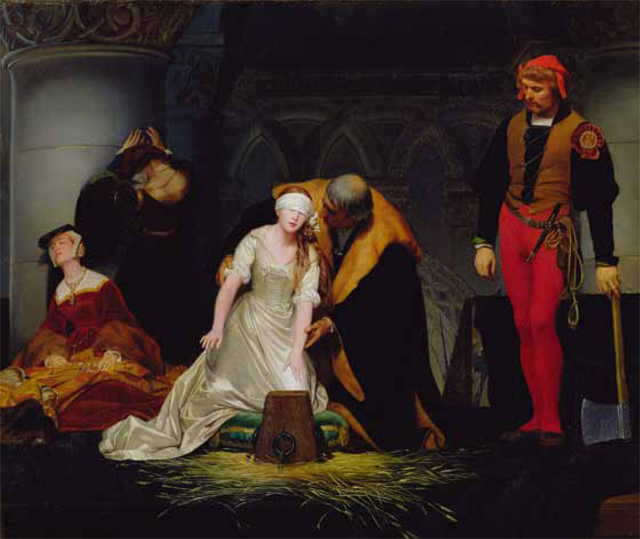My Favourite Painting: Giles Deacon
Giles Deacon chooses his favourite painting for Country Life.


The Execution of Lady Jane Grey, 1833, 97in by 116in, by Paul Delaroche (1797–1856), The National Gallery, London. Bridgeman Images.
Giles Deacon says: 'I first came across this painting when studying at Central St Martin’s in 1989. What fascinated me was the eerie manner in which Jane is blindfolded in a satin dress surrounded by ladies-in-waiting as a relaxed executioner creates a very clean scene for what is about to occur; I presume the pristine dress and clean straw are to intensify the imminent bloody scene to follow. I like the prevailing calm before the storm and find the colours continually arresting.'
Giles Deacon is a fashion designer. His BT ArtBox will be auctioned at the National Portrait Gallery for ChildLine’s 25th Anniversary today.
Art critic John McEwen comments: 'In 1928, the Tate was flooded by the Thames. Jane Grey was one of 18 stored oil paintings listed as ‘completely spoiled’. They were left as written-off rolls until, 45 years later, Christopher Johnstone, a young Tate curator, inadvertently unearthed Jane Grey, which proved to be in almost pristine condition. The pictures’ neglect reflected that, even before the flood, they had been designated ‘not of primary importance’. Hence Jane Grey’s demotion from the National Gallery, to which it had been bequeathed in 1902, to the National Gallery Millbank, as the Tate was first named.
Today, reinstated at the Trafalgar Square HQ, the constantly revarnished floor at its foot is testimony to the picture being one of the most popular in the entire collection. The same was true when it was first shown in 1834. It caused a sensation at the Paris Salon, placing Delaroche on a par with his contemporaries Ingres and Delacroix. His specialising in subjects from English history prolonged his reputation here until the turn of the century. In England, he remained the supreme French painter of the 19th century and he has pride of place in the Podium of Painters frieze on the Albert Memorial in Kensington Gardens.
The scholarly Lady Jane Grey, Edward VI’s second cousin and named by him as his successor in preference to his half-sisters Mary and Elizabeth, was no lamb to the slaughter, despite being only 16. Queen for nine days following Edward’s death, she was deposed and executed by the Catholic Mary, but ascended the gallows a resolute Protestant martyr.'
This article was first published in Country Life, July 18, 2012
Sign up for the Country Life Newsletter
Exquisite houses, the beauty of Nature, and how to get the most from your life, straight to your inbox.
Country Life is unlike any other magazine: the only glossy weekly on the newsstand and the only magazine that has been guest-edited by HRH The King not once, but twice. It is a celebration of modern rural life and all its diverse joys and pleasures — that was first published in Queen Victoria's Diamond Jubilee year. Our eclectic mixture of witty and informative content — from the most up-to-date property news and commentary and a coveted glimpse inside some of the UK's best houses and gardens, to gardening, the arts and interior design, written by experts in their field — still cannot be found in print or online, anywhere else.
-
 ‘It had the air of an ex-rental, and that’s putting it politely’: How an antique dealer transformed a run-down Georgian house in Chatham Dockyards
‘It had the air of an ex-rental, and that’s putting it politely’: How an antique dealer transformed a run-down Georgian house in Chatham DockyardsAn antique dealer with an eye for colour has rescued an 18th-century house from years of neglect with the help of the team at Mylands.
By Arabella Youens
-
 A home cinema, tasteful interiors and 65 acres of private parkland hidden in an unassuming lodge in Kent
A home cinema, tasteful interiors and 65 acres of private parkland hidden in an unassuming lodge in KentNorth Lodge near Tonbridge may seem relatively simple, but there is a lot more than what meets the eye.
By James Fisher
-
 My favourite painting: Allan Mallinson
My favourite painting: Allan MallinsonMilitary historian Allan Mallinson picks an image of 'faith, generosity and ultimate sacrifice'.
By Charlotte Mullins
-
 My Favourite Painting: Piet Oudolf
My Favourite Painting: Piet Oudolf'One cannot sense whether he is far out on the ocean or closer to shore, or what he may be watching or feeling in that moment as he stares towards the beach.’
By Country Life
-
 My Favourite Painting: Mary Plazas
My Favourite Painting: Mary Plazas'There is compassion, awe, humility, a knowing yet a questioning in the glistening eyes. It moves me, it inspires me beyond the need to know.’
By Country Life
-
 My favourite painting: Robert Kime
My favourite painting: Robert KimeRobert Kime shares his fondness for New Year Snow by Ravilious
By Country Life
-
 My Favourite Painting: Anna Pavord
My Favourite Painting: Anna PavordAnna Pavord chooses a picture which reminds her of where she grew up
By Country Life
-
 My favourite painting: The Duchess of Wellington
My favourite painting: The Duchess of WellingtonThe Duchess of Wellington chooses her favourite painting for Country Life.
By Country Life
-
 My favourite painting: Maureen Lipman
My favourite painting: Maureen LipmanMaureen Lipman chooses her favourite painting for Country Life.
By Country Life
-
 My favourite painting: Jacqueline Wilson
My favourite painting: Jacqueline Wilson'I looked at this painting and decided to write about a Victorian circus girl one day'
By Country Life